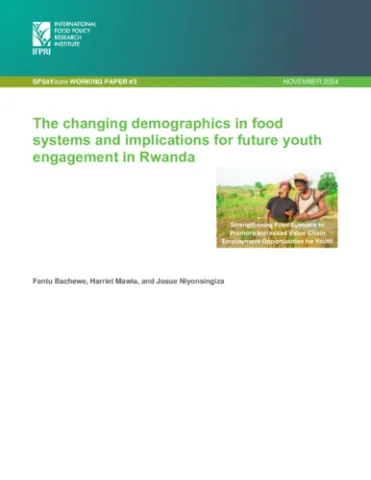The changing demographics in food systems and implications for future youth engagement in Rwanda

Abstract
Food systems are critically important for food security and employment in Sub-Saharan Africa (SSA). Moreover, expansion of nonfarm components of food systems (FS) reinforces efforts to transition out of agriculture. FS, particularly off-farm segments of food value chains, must grow rapidly to guarantee food and nutrition security for growing populations and to provide the quantity and variety of food demanded as a result of increases in urbanization and income, as well as to accommodate accompanying technological and other changes. The impact, inevitability, and amenability to policy interventions of these factors and the extent of FS transformation needed differs across countries. Future FS also face several emerging challenges. Employment and job creation are among the areas that are significantly affected by FS transformation. Demographic changes that accompany expanding FS employment are also critical for gender equity and youth inclusion. The extent, speed, and complementarity of the FS transformation and increased employment varies across countries. However, there is currently no system in place to monitor the extent of FS transformation or its interactions with other aspects of the economy, such as employment. This study of Rwanda uses secondary data from the International Labour Organization (ILO) (2023), World Bank (2023), and Integrated Household Living Conditions Survey (EICV) (2023) to investigate demographic trends in overall FS employment and who is and is not engaging in FS; and to document sectoral and overall economic growth, population and demographic changes, and urbanization trends—all which influence and are influenced by FS growth. The study contributes to the literature by testing the predicted patterns of employment growth and inclusiveness in agrifood systems, and by pointing to the nodes of employment in FS where gender- and age-based inequities exist, thereby facilitating policymaking and interventions to ameliorate the problems. In addition, tracking performance in employment-related Sustainable Development Goals (SDGs) in Rwanda contributes to our understanding of the progress made in SSA toward inclusiveness, efficiency, and poverty reduction, particularly progress that benefits women and the youth. Rwanda’s economy grew remarkably during the two decades covered in the study (2001–2022). Agriculture contributed significantly to gross domestic product (GDP) as well as to overall and FS employment. Per capita income more than doubled, although it still is about half the average GDP per capita of SSA. The population, threequarters of whom are under 35 years of age, increased by 70% during the period. There have been great strides in education, particularly for girls and women. However, urbanization has been slow, and half of the country’s urban residents live in the capital city. The unemployment rate in Rwanda has been twice the SSA average and has generally been increasing. More than half of the workers are employed in agriculture, although this share declined considerably during the period. Farming contributes significantly to FS employment. However, the share of overall FS employment declined during the period, due to a decline in farming employment accompanied by stagnant employment in non-farm FS. Relative to men, women’s overall labor force participation rate is considerably lower and their unemployment rate higher. A larger share of women work in low-skill jobs and this gap increased during the period; a relatively larger share of women are employed in FS, but a smaller share work in the nonfarm component of FS and this gender gap widened. Similarly, relative to mature adults, youth are less advantaged. The labor force participation rate of youth is considerably lower, and the rate of unemployment is higher and increasing relatively faster among youth. However, differences in FS employment among youth and mature adults were considerably lower and shown no clear trend. Findings of this study point to several short- and long-run policy implications.
